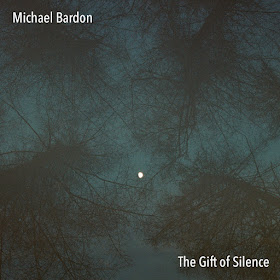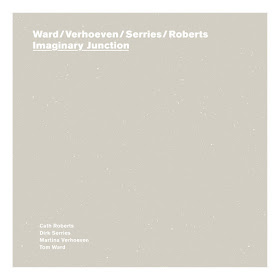By Nick Ostrum
A New Wave of Jazz is a label run by Dirk Serries whose first activities
reach back to 2015. Since then, it has accrued over 50 releases of free
jazz and related minimalist music, if one takes into account those
recordings released through their subscriber service. Many of these involve
Serries himself; others do not. Invariably, however, these releases are
compelling, when not also pushing the boundaries of their respective
aesthetic corners. Below is a review of several of the label’s recent duo
releases, and one quartet, which was a long-distance pandemic
collaboration.
Tom Jackson and Colin Webster – The Other Lies (A New Wave of
Jazz, 2021)
Tom Jackson : clarinet
Colin Webster : alto and baritone saxophones
It begins with protracted, stable layered tones. First Jackson, then
Webster deviate into more active territory, but still hold back in volume
as the piece builds in intensity. They then slip into ping pong of short
chirpy phrases, feinted wells of sound, and percolation, huffs and
whispers. Although each of The Other Lies’ six tracks has its own
focus and intensity, all are somewhat restrained considering much of
Webster’s other work. And they are all the more interesting because of it.
Indeed, these pieces, all improvised, run the gamut from long-tone
minimalism to a sprightly neoromantic races to free arrhythmia. Webster and
Jackson are both deft reedists and, although they do not follow the
post-modern extended techniques playbook completely, they add just enough
clucks, squeaks, tinny trills and breath to keep this duo session
interesting for the entire hour it runs.
John Edwards and Dirk Serries – Melancholia (A New Wave of Jazz,
2021)
John Edwards: double bass
Dirk Serries: acoustic guitar
Two masters of improv, an acoustic guitar and a double bass. What is not to
like? This is very much what one would expect from John Edwards and Dirk
Serries. It ebbs; it flows; it contorts. Serries’ metallic strums are met
tit for tat by Edwards. Edwards’ itinerancy is circled by Serries’ clangy
runs. And vice versa. Edwards deploys his array of techniques, shifting
from extended periods of strums to struts to scratchy bowing. Both
musicians really show some patient creativity, here, without grandstanding
or grooving. Some of that likely has to do with the intimacy of these types
of duo sessions. It gives him and Serries space, especially in the second
of two tracks, to explore their own corners of sound when they are not
looping through each other. Little information about the meeting is
offered, though this sounds like a free improv meeting, wherein ideas may
have been discussed beforehand but little was put on paper and parameters
rather than charts were set.
NB: Raw Tonk has a
quartet release
featuring Edwards, Serries, Colin Webster and Andrew Lisle recorded at
these same sessions. I am not sure which was recorded first in the day,
though I would wager Melancholia was. Regardless, taking the two
together displays just how adaptive and responsive Edwards and Serries are.
Despite a similar tendency toward subtlety and understatement, Peck and Fleet is a very different release.
Anton Mobin & Martina Verhoeven – Cure and Mound (A New Wave
of Jazz, 2021)
Anton Mobin: prepared chamber
Martina Verhoeven: piano
I was very excited when I first encountered Cure and Mound. I
first encountered Anton Mobin’s work years ago, through
live online release
with Thomas Thiery through Audioactivity. Since then, I know he has worked
extensively with field recordings and cut-and-paste musique concrete and
was featured on disc 5 of the Sonny Simmons box-set
Leaving Knowledge, Wisdom And Brilliance
/
Chasing the Bird
. That said, I, in my restricted corner of listening, have not really heard
much of him since. On Cure and Mound, he joins pianist Martina
Verhoeven for a compelling romp through some strange sonic terrains. This
is another duo, like the previous two, recorded in February of 2020, right
before Covid got real for many of us and the bare-bones (and heavily
produced) solo, then duo, became the ensemble of choice. Indeed, this
sounds more social than that. Recorded only a few months later, this almost
inevitably would have been a remote affair. (See below for a success in
remote improvisation and convincing cohesion.)
Verhoeven and Mobin engage is a brilliantly noisy dance, the metallic
clangor of the piano and the tortured grind of Mobin’s prepared chamber
(see a description and image here)
intermingle into a single, scraping force. Verhoeven herself shuffles
between truncated phrases on the keys and pounding the piano, both inside
and out, implying some extra-acoustic elements through extended techniques
and piled sounds. For his part, Mobin bends the electroacoustic barrier in
his custom box of objects, pickups and contact mics, which contribute
further to the listener’s wonder of where exactly these sounds emanated.
Although some of this is more tuneful, such when Verhoeven stretches out
about two-thirds into the first track, it is more generally noisy,
cacophonous and glitchy. And wonderfully so.
Tom Ward, Martina Verhoeven, Dirk Serries, Cat Roberts – Imaginary Junction (A New Wave of Jazz, 2020)
Cath Roberts : baritone saxophone and objects
Dirk Serries : acoustic guitar
Martina Verhoeven : piano
Tom Ward : flute, clarinet and bass clarinet
I had wanted to hear more from Cath Roberts ever since I reviewed some of
her
archival releases
from the beginning of the pandemic. When I saw Imaginary Junction,
with NWJ label-owner and prolific guitarist Serries in addition to
Verhoeven (see above) and the hitherto-unknown-to-me Tom Ward on other
reeds and flute, I jumped at the opportunity to listen. As far as Roberts’
work, this is some of the best I have heard yet.
The musicians here are remarkably responsive given the situation. This
sounds like good, practiced, live improv. And, in a sense, this is live. It
was recorded in two locations – Brockley, England and Sint-Lenaarts,
Belgium – simultaneously, though the two locations were reacting to each
other remotely. For such a situation, however, this sounds remarkably
tight. Sometimes Roberts and Ward dance together as the leads. At others
Serries and Verhoeven enlace their strings. (I assume these are the duos
respectively in Brockley and Sint-Lenaarts.) These, however, are hardly
sections in the strict sense, even if the reeds tend to take the amelodic
front and Verhoeven and Serries often provide the nonrhythmic backing. This
is deeply steeped in European free improv, albeit with the tonal dynamics
and odd sounds that root it more firmly in the present. In short, it shows
Roberts, Serries, Verhoeven and Ward can hold their own and create some
truly compelling music together even in unconventional circumstances.





























